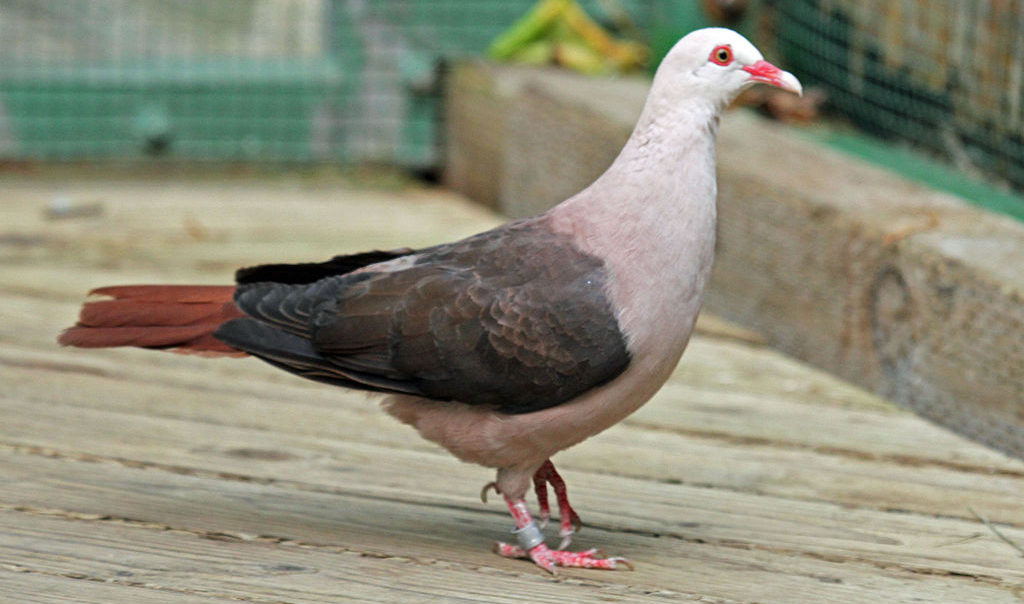SCORES & OUTDOORS: Pink flamingos, yes; but pink pigeons?
 by Roland D. Hallee
by Roland D. Hallee
I came across something quite interesting last week while watching the Animal Planet network. It was a story about Pink Pigeons. Now, you have your general, run-of-the-mill rock doves, or common pigeons, that we all know all too well, marking up our landscape and just making a plain nuisance of themselves in parks, parking lots, and at backyard feeders. But these guys, the pink pigeons, were a little different.
Pink pigeons, not classified as a true pigeon, are endemic to Mauritius, an island nation in the Indian Ocean about 1,200 miles off the southeast coast of the African continent.
The pink pigeon was on the brink of extinction in 1991 when only 10 individual birds remained, but its numbers have increased recently due to the efforts of the Durrell Wildlife Conservations Trust since 1977. While the population, estimated at 450 birds in 2011, is still of concern, the International Union for Conservation of Nature (IUCN) downlisted the species from critically endangered to endangered in 2000. A healthy captive population is also kept as “backup.”
Reclassified with recent DNA tests, the pink pigeon is more closely related to the Madagascar turtle dove, and has been suggested that it takes its place with a genus mostly contained as turtle doves.
An adult pink pigeon is about 14 – 15 inches in length from its beak to tail. They have pale pinkish-gray plumage on their head, shoulders and underside, along with pink feet. The beak is a drak pink color with a white tip.They have dark brown wings, and a broad, rust-colored tail. Their eyes are dark brown surrounded by an eye-ring of red skin.
A related subspecies, the Reunion pink pigeon, that resided on the neighboring Reunion Island, became extinct around 1700. As of 2016, there are five locations where wild populations of the pink pigeon can be found. Four of these locations belong to Black River Gorges National Park and the fifth to the Isle aux Aigrettes.
The species is not migratory.
They prefer upland evergreen forests, although they can also be found in coastal forests as long as the vegetation is native and not dominated by introduced species such as Chinese Guava or the privet. Destruction of such primal forests has been a major cause for its decline in numbers.
There are more males than females in the population due to a greater life expectancy of the male – about five years more. One reason for the difference is that producing eggs is extremely taxing on the female. Female birds are nearly constantly producing eggs – similar to the domesticated chickens. This can end up totaling to a large metabolic tax on the female’s survival.
Habitat degradation, introduced predators and wildlife disease are the major ongoing threats to the pink pigeon’s survival. Only two percent of the native forest remains on Mauritius. Common predators include the crab-eating macaque, the small Asian mongoose, rats and feral cats. Invasive plants such as the Chinese guava and privet dominate native forest plants, preventing their growth.
Feeding stations that provide supplementary feed may accelerate the spread of disease between individuals, since they congregatge at greater than normal numbers at stations. An ongoing concern faced by the pink pigeons, as by many other endangered species that exist in small remnant populations, is inbreeding depression.
Several foundations and organizations have contributed to conservation efforts. In addition to direct conservation efforts such as captive breeding, genetic research, and supplementary feeding efforts, more general research on the species may aid in the formation of more applicable conservation actions.
It’s an interesting species of bird that exists in only a small area of the world, far away from central Maine. But it’s still interesting to learn about this wildlife that I had not heard of a week ago.
Roland’s trivia question of the week:
Which MLB pitcher owns the distinction of having won the most games, and having lost the most games during his career?
Responsible journalism is hard work!
It is also expensive!
If you enjoy reading The Town Line and the good news we bring you each week, would you consider a donation to help us continue the work we’re doing?
The Town Line is a 501(c)(3) nonprofit private foundation, and all donations are tax deductible under the Internal Revenue Service code.
To help, please visit our online donation page or mail a check payable to The Town Line, PO Box 89, South China, ME 04358. Your contribution is appreciated!



Leave a Reply
Want to join the discussion?Feel free to contribute!